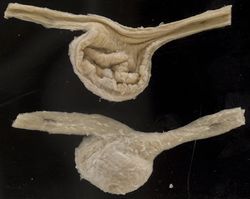Difference between revisions of "Crop - Anatomy and Physiology"
| Line 26: | Line 26: | ||
[[Category:Avian Alimentary System - Anatomy & Physiology]] | [[Category:Avian Alimentary System - Anatomy & Physiology]] | ||
| − | [[Category:To Do - AimeeHicks]] | + | [[Category:To Do - AimeeHicks]][[Category:To Do - Review]] |
Revision as of 11:00, 10 September 2010
Introduction
The crop is a food storage device present in avian species. It is usually used when the muscular stomach (gizzard) is full. The crop also softens food.
It is a useful tool for avian veterinarians and owners for assessing when the bird last ate and it is especially important to ensure young chicks always have full crops. It is also a common site for impactions and surgical entry to remove foreign bodies.
Structure and Function
The crop is a muscular chamber. It is a fusiform enlargement of the oesophagus. Thoracic inlet of the ventral wall of the oesophagus. It bulges and lies against the breast muscles.
Innervation
The crop is innervated by the vagus nerve (CN X).
Species Differences
The crop is small in ducks and geese and is much larger and muscular in seed eating birds. Pigeons have epithelial cells in their crop sensitive to prolactin which slough when chicks (squabs) hatch, producing crop milk. Owls have no storage facility in their crops, so produce a pellet of indigestible material after every meal.
Links
Test yourself with the Avian Alimentary Tract Flashcards
Click here for more information on the Oesophagus - Anatomy & Physiology
